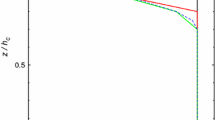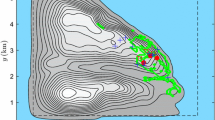Abstract
Over the past two decades, several inverse methods have been proposed to estimatescalar source and sink strengths from measured mean concentration profiles withinthe canopy volume (hereafter termed the `inverse' problem). These inverse methodscommonly assumed neutral atmospheric stability conditions for the entire canopyvolume. For non-neutral conditions, atmospheric stability corrections in inverseschemes were limited to adjusting the integral time scale or other flow statistics tomatch well-established surface-layer similarity relations above the canopy. Suchstability corrections do not explicitly consider the local stability effects within thecanopy volume. Currently, there is no satisfactory inverse scheme that explicitlyaccounts for local atmospheric stability for canopy turbulence. A Eulerian inversemethod that explicitly accounts for local atmospheric stability within the canopy isdeveloped using second-order closure principles. Field testing the method is conductedusing temperature measurements from two field experiments collected in an even-ageduniform loblolly pine forest. It is demonstrated that by accounting for local atmospheric stability in the inversion scheme, the agreement between modelled sensible heat flux calculations and measurements improve by 60% for stable conditions, 10% for near-neutral conditions and 20% for unstable conditions
Similar content being viewed by others
References
Anthoni, P. M., Law, B. E., and Unsworth, M. H.: 1999, 'Carbon and Water Vapor Exchange of an Open-Canopied Ponderosa Pine Ecosystem', Agric. For. Meteorol. 95, 151-168.
Baldocchi, D. and Harley, P. C.: 1995, 'Scaling Carbon Dioxide and Water Vapor Exchange from Leaf to Canopy in a Deciduous Forest. II Model Testing and Application', Plant Cell Environ. 18, 1157-1173.
Baldocchi, D. and Meyers, T.: 1998, 'On the Eco-Physiological and Biogeochemical Theory to Evaluate Carbon Dioxide, Water Vapor and Trace Gas Fluxes over Vegetation: A Perspective', Agric. For. Meteorol. 90, 1-25.
Begg, J. E., Bierhuizen, J. F., Lemon, E. R., Misra, D. K., Slatyer, R. O., and Stern, W. R.: 1964, 'Diurnal Energy and Water Exchanges in Bulrush Millet in a Area of High Solar Radiation', Agric. Meteorol. 1, 294-312.
Brown, K. W. and Covey, W.: 1966, 'The Energy-Budget Evaluation of the Micro-Meteorological Transfer Processes within a Cornfield', Agric. Meteorol. 3, 73-96.
Culf, A. D., Fisch, G., Malhi, Y., and Nobre, C. A.: 1997, 'The Influence of the Atmospheric Boundary Layer on Carbon Dioxide Concentrations over a Tropical Forest', Agric. For. Meteorol. 85, 149-158.
Denmead, O. T.: 1995, 'Novel Meteorological Methods for Measuring Trace Gas Fluxes', Phil. Trans. Roy. Soc. of London A 351, 383-396.
Denmead, O. T. and Raupach, M. R.: 1993, 'Methods for Measuring Atmospheric Gas Transport in Agricultural and Forest System, in J. M. Duxbury, L. A. Harper, A. R. Mosier, and D. E. Rolston (eds.), Agricultural Ecosystem Effects on Trace Gases and Global Climate Change, American Society of Agronomy, Madison, pp. 19-43.
Denmead, O. T., Harper, L. A., and Sharpe, R. R: 2000, 'Identifying Sources and Sinks of Scalars in a Corn Canopy with Inverse Lagrangian Dispersion Analysis: I. Heat', Agric. For. Meteorol. 104, 67-73.
Finnigan, J. J.: 1985, 'Turbulent Transport in Plant Canopies', in B. A. Hutchinson and B. B. Hicks (eds.), The Forest-Atmosphere Interactions, D. Reidel, Norwell, MA, pp. 443-480.
Gao, W., Wesely, M. L., and Doskey, P. V.: 1993, 'Numerical Modelling of the Turbulent Diffusion and Chemistry of NOx, O3, Isoprene, and Other Reactive Trace Gases in and above a Forest Canopy', J. Geophys. Res. 98, 18,339-18,353.
Gu, L. H., Shugart, H. H., Fuentes, J. D., Black, T. A., and Shewchuk, S. R.: 1999, 'Micrometeorology, Biophysical Exchange and NEE Decomposition in a Two-Story Boreal Forest-Development and Test of an Integrated Model', Agric. For. Meteorol. 94, 123-148.
Kaimal, J. C. and Finnigan, J. J.: 1994, Atmospheric Boundary Layer Flows: Their Structure and Measurement, Oxford Press, 289 pp.
Katul, G. G. and Albertson, J. D.: 1998, 'An Investigation of Higher Order Closure Models for a Forested Canopy', Boundary-Layer Meteorol. 89, 47-74.
Katul, G. G. and Albertson, J. D.: 1999, 'Modeling CO2 Sources, Sinks and Fluxes within a Forest Canopy', J. Geophys. Res. 104, 6081-6091.
Katul, G. G. and Chang, W.-H.: 1999, 'Principal Length Scales in Second-Order Closure Models for Canopy Turbulence', J. Appl. Meteorol. 38, 1631-1643.
Katul, G. G., Hsieh, C. I., Bowling, D., Clark, K., Shurpali, N., Turnipseed, A., Albertson, J. D., Tu, K., Hollinger, D., Evans, B., Offerle, B., Anderson, D., Ellsworth, D., Vogel, C., and Oren, R.: 1999, 'Spatial Variability of Turbulent Fluxes in the Roughness Sublayer of an Even-Aged Pine Forest', Boundary-Layer Meteorol. 93, 1-28.
Katul, G. G., Leuning, R., Kim, J., Denmead, O. T., Miyata, A., and Harazono, Y.: 2001, 'Estimating CO2 Source/Sink Distributions within a Rice Canopy Using Higher-Order Closure Models', Boundary-Layer Meteorol. 98, 103-125.
Katul, G. G., Oren, R., Ellsworth, D., Hsieh, C. I., Phillips, N., and Lewin, K.: 1997a, 'A Lagrangian Dispersion Model for Predicting CO2 Sources, Sinks, and Fluxes in a Uniform Loblolly Pine (Pinus taeda L.) Stand', J. Geophys. Res. 102, 9309-9321.
Katul, G. G., Hsieh, C. I., Kuhn, G., Ellsworth, D., and Nie, D.: 1997b, 'Turbulent Eddy Motion at the Forest-Atmosphere Interface', J. Geophys. Res. 102, 13,409-13,421.
Lai, C. T., Katul, G., Orem, R., Ellsworth, D., and Schafer, K.: 2000, 'Modelling CO2 and Water Vapor Turbulent Flux Distributions within a Rorest Canopy', J. Geophys. Res. 105, 26,333-26,351.
Law, B. E., Baldocchi, D. D., and Anthoni, P. M.: 1999, 'Below-Canopy and Soil CO2 Fluxes in a Ponderosa Pine Forest', Agric. For. Meteorol. 94, 171-188.
Leclerc, M. Y., Thurtell, G. W., and Kidd, G. E.: 1988, 'Measurements and Langevin Simulations of Mean Tracer Concentration Fields Downwind from a Circular Line Source inside an Alfalfa Canopy', Boundary-Layer Meteorol. 43, 287-308.
Lee, X. H: 1998, 'On Micrometeorological Observations of the Surface-Air Exchange over Tall Vegetation', Agric. For. Meteorol. 91, 39-49.
Leuning, R.: 2000, 'Estimation of Scalar Source/Sink Distributions in Plant Canopies Using Lagrangian Dispersion Analysis: Corrections for Atmospheric Stability and Comparison with a Multilayer Canopy Model', Boundary-Layer Meteorol. 96, 293-314.
Malhi, Y, Nobre, A. D., Grace, J. G., Kruijt, B., Pereira, M. G. P., Culf, A., and Scott, S.: 1998, 'Carbon Dioxide Transfer over a Central Amazonian Rain Forest', J. Geophys. Res. 103, 31,593-31,612.
Massman, W. J. and Weil, J. C.: 1999, 'An Analytical One Dimensional Second-Order Closure Model of Turbulence Statistics and the Lagrangian Time Scale within and above Plant Canopies of Arbitrary Structure', Boundary-Layer Meteorol. 91, 81-107.
Meyers, T. and Paw U, K. T.: 1987, 'Modelling the Plant Canopy Micrometeorology with Higher-Order Closure Principles', Agric. For. Meteorol. 41, 143-163.
Potosnak, M., Wofsy, S. C., Denning, A. S., Conway, T. J., Munger, J. W., and Barnes, D. H.: 1999, 'Influence of Biotic Exchange and Combustion Sources on Atmospheric CO2 Concentrations in New England from Observations at a Forest Flux Tower', J. Geophys. Res. 104, 9561-9569.
Rannik, U.: 1998, 'On the Surface Similarity at a Complex Forest Site', J. Geophys. Res. 103, 8685-8697.
Raupach, M. R.: 1989a, 'Applying Lagrangian Fluid Mechanics to Infer Scalar Source Distributions from Concentration Profiles in Plant Canopies', Agric. For. Meteorol. 47, 85-108.
Raupach, M. R.: 1989b, 'A Practical Lagrangian Method for Relating Scalar Concentrations to Source Distributions in Vegetation Canopies', Quart. J. Roy. Meteorol. Soc. 115, 609-632.
Raupach, M. R.: 1988, 'Canopy Transport Processes, in W. L. Steffen and O. T. Denmead (eds.), Flow and Transport in the Natural Environment, Springer-Verlag, New York, pp. 95-127.
Raupach, M. R. and Shaw, R. H.: 1982, 'Averaging Procedures for Flow within Vegetation Canopies', Boundary-Layer Meteorol. 22, 79-90.
Raupach, M. R., Denmead, O. T., and Dunin, F. X.: 1992, 'Challenges in Linking Atmospheric CO2 Concentrations to Fluxes at Local and Regional Scales', Aust. J. Bot. 40, 697-716.
Simpson, I. J., Thurtell, G. W., Neumann, H. H., Den Hartog, G., and Edwards, G. C.: 1998, 'The Validity of Similarity Theory in the Roughness Sublayer above Forest', Boundary-Layer Meteorol. 87, 69-99.
Siqueira, M., Lai, C. T., and Katul, G.: 2000, 'Estimating Scalar Sources, Sinks, and Fluxes in a Forest Canopy Using Lagrangian, Eulerian, and Hybrid Inverse Models', J. Geophys. Res. 105, 29,475-29,488.
Vermetten, A.W. M., Ganzeveld, L., Jeuken, A., Hofschreuder, P., and Mohren, G.M. J.: 1994, 'CO2 Uptake by a Stand of Douglas-Fir-Flux Measurements Compared with Model-Calculations', Agric. For. Meteorol. 72, 57-80.
Warland, J. S. and Thurtell, G. W.: 2000, 'A Lagrangian Solution to the Relationship between a Distributed Source and Concentration Profile', Boundary-Layer Meteorol. 96, 453-471.
Wilson, J. D.: 1988, 'A Second Order Closure Model for Flow through Vegetation', Boundary-Layer Meteorol. 42, 371-392.
Wilson, N. R. and Shaw, R. H.: 1977, 'A Higher Order Closure Model for Canopy Flow', J. Appl. Meteorol. 16, 1198-1205.
Wofsy, S. C., Goulden, M. L., Munger, J. W., Fan, S. M., Bakwin, P. S., Daube, B. C., Bassow, S. L., and Bazzaz, F. A.: 1993, 'Net Exchange of CO2 in a Mid-Latitude Forest', Science 260, 1314-1317.
Wright J. L. and Brown, K. W.: 1967, 'Comparison of Momentum and Energy Balance Methods of Computing Vertical Transfer within a Crop', Agron. J. 59, 427-432.
Author information
Authors and Affiliations
Corresponding author
Rights and permissions
About this article
Cite this article
Siqueira, M., Katul, G. Estimating Heat Sources And Fluxes In Thermally Stratified Canopy Flows Using Higher-Order Closure Models. Boundary-Layer Meteorology 103, 125–142 (2002). https://doi.org/10.1023/A:1014526305879
Issue Date:
DOI: https://doi.org/10.1023/A:1014526305879




